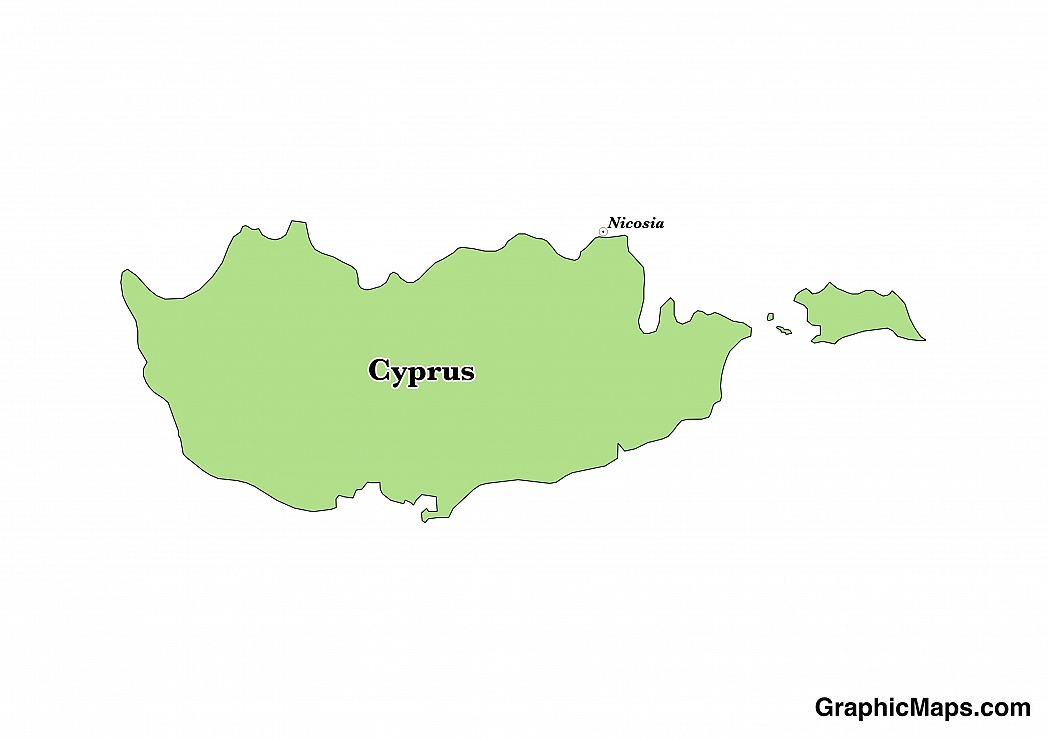Where is Cyprus?
Due to 1960 Treaty of Establishment that created the independent Republic of Cyprus, the UK retained full sovereignty and jurisdiction over two areas of almost 254 square kilometers - Akrotiri and Dhekelia. Cyprus has 156 km border with these bases. It has a 648.00 km coastline. Hostilities on the island in 1974 divided it into two de facto autonomous.
The capital of Cyprus is Nicosia. It became the capital in 1960 when the country gained independence. It can trace its history up to the Bronze Age which makes it the oldest settlement in the country. It is divided into the Greek quarter, which is mostly inhabited by Greek Cypriots, and the Turkish quarter, which is mostly inhabited by Turkish Cypriots. The northern part of the city is also the capital of the Turkish Republic of Cyprus. Turkey is the only country that recognizes the status of this republic. The buffer zone dividing the two quarters is still attended by a peacekeeping team from the United Nations. It has numerous tourist attractions to offer thanks to its rich history such as the Venetian walls which were built in the 16th Century and the Cyprus Museum. The climate is sub-tropical semi-arid climate with long dry summers and cool and sometimes wet winters.
Read more on Cyprus's CapitalCyprus is a European country covering 9,251.00 km2 of which 0.11% is water and 9,241.00 km2 is land. This makes it the 33rd smallest country in the world and about 0.6 times the size of Connecticut. Its geographic coordinates are 35 00 N, 33 00 E and Nicosia is the capital city.
The country is named for the marine crocodiles living on the island.
Its ISO code is CY.
Geography
Cyprus has a mean elevation of 91 m above sea level.
It has a temperate, Mediterranean climate with hot, dry summers and cool winters. Its terrain is predominantly mountainous, with some plains along the southern coast.
Population
Cyprus has a population of 1,205,575 making it the 159th largest in the world. The population is mostly concentrated in the city of Nicosia.
Greek is the official language, as well as Turkish. The major ethnic group is Greeks. The majority of the population is Orthodox Christian.
The island is divided into The Republic of Cyprus in the South, which is occupied by Greek Cypriots, and the Turkish Republic of Cyprus which is in the Northern part of the country and is occupied by Turkish Cypriots. The two main languages that are officially recognized on the island are the Greek language, which uses the Greek alphabet and has 24 letters and the Turkish language which has 29 letters. The Republic of Cyprus also recognizes two minor languages. These are Armenian and Cypriot Arabic. A third minor language used in the Island is Kurbetcha. Northern Cyprus only officially recognizes the Turkish language even though English is widely used and is taught as a second language in government schools.
Read more on Cyprus's LanguagesThe dialing code for the country is 357.
Government
Cyprus is an independent country. It gained independence from the United Kingdom in 1960. Its constitution was last ratified in 1960.
The Republic of Cyprus is headed by the president. The system of government is a presidential democracy. The invasion of the Turkish community in the north in 1974 led to the division of Cyprus and formation of the Turkish Republic of Northern Cyprus, although the Cyprus government is the internationally recognized authority of the Island. The parliament of Cyprus is called the House of Representatives. Both presidential elections and elections of parliamentary representatives are held after every five years. By law, the head of the House of Representatives should be Greek and the vice president from the Turk community. Dominant political parties in the Republic of Cyprus are DISY, AKEL, DIKO, and EDEK. Eligible voters are those aged 18 and above, and people who set their residence in Cyprus six months before becoming eligible to vote.
Read more on Cyprus's GovernmentEconomy
Factoring in Purchasing Power Parity, Cyprus's GDP is $29,260,000,000.00 (USD) with $34,400.00 (USD) per capita. This makes it the 132nd largest economy and its citizens the 53rd richest in the world. The currency of Cyprus is the Euro (EUR).
Its major export partners are Greece, Ireland, and the United Kingdom. Its main exports are citrus, potatoes, pharmaceuticals, and cement. Its major import partners are Greece, the United Kingdom, and Italy. Its major imports include consumer goods, petroleum, and machinery.
Flag
Cyprus is the only country in the world to have the silhouette of itself depicted on its national flag. The flag is white with the map of the country at the middle with two crossed olive-green branches below it. The flag was adopted in 1960 after a competition in which Ismet Guney, an art teacher, won. The white color on the flag signifies peace, the two olive branches symbolize the hope for harmony and reconciliation for both the Turkish and Greek inhabitants. The copper colored map is a representation of the availability of copper metal in the country. Before the present Cyprus flag was adopted, the British colonial flag was used and was later updated with a Union Jack in the top left corner and two lions in the center in a dark blue background. Often the Greek community uses the current flag while the Turkish community uses it alongside the flag of Northern Cyprus.
Read more on Cyprus's FlagThis page was last modified on January 17th, 2018
More on Graphicmaps

Published on 2019-11-06
What is a Trade Embargo?

Published on 2019-11-04
Which Two Countries Used to Have the Same Flag?

Published on 2019-09-16
What Is the Only Two-Sided State Flag?

Published on 2019-09-16
Which Country Flag Looks Like the Texas Flag?

Published on 2019-08-29
Flags That Resemble the US Flag

Published on 2019-08-20
